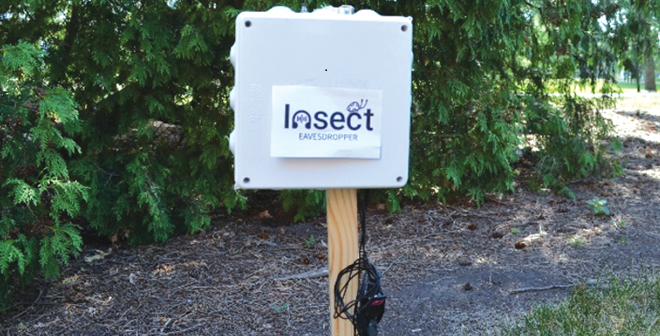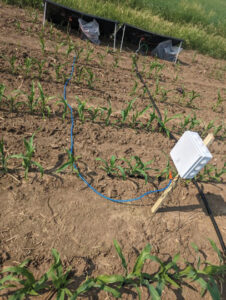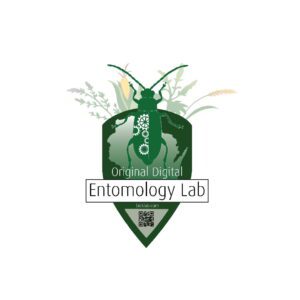
Mar 27, 2024Tech allows growers to ‘eavesdrop’ on insects
Emily Bick, assistant professor of precision pest ecology and Extension specialist for the University of Wisconsin-Madison, is compiling the ultimate playlist for her field of expertise.
Bick runs the university’s Original Digital Entomology Lab. She describes the lab’s mission as finding out how to “use these fancy, cutting-edge, novel digital tools for better time and space insect pest interventions in agriculture.”


That’s why Bick and other researchers across the globe are collecting what she calls a “library of sound” — not of music, but:
- Piercing-sucking insects, such as the strawberry lygus bug, as they feed.
- Colorado potato beetles defoliating certain vegetable crops.
- Corn rootworms as they munch away, unseen by crop scouts.
- Leafhoppers on cherry and other fruit trees.
The goal is to develop a database that growers, crop consultants and researchers can consult using the Insect Eavesdropper, the latest in the evolution of pest detection that has used everything from gramophone needles and laser vibrometers to detect pests in the field. For decades, the technology has been expensive and imperfect, with systems costing up to $7,000 just to rent for one season, with some technology prone to picking background noise.
Bick and Dev Mehrotra, a computer science engineering student and project lead, found the right combination of hardware to detect pests wherever they feed on crops, including hidden away as they bore into stalks.
The device is made up of a contact microphone that’s clipped onto a plant, and a minicomputer that records feeding events.
While the technology can detect pests that feed on roots or suck on the plants, Bick said it’s also important what the Insect Eavesdropper doesn’t document: insects walking on leaves or flying nearby. The device will “hear” bees feeding and drinking, but not interacting with plants as they collect pollen.


Bick said the Insect Eavesdropper is about two years away from commercial release. The device is up-to-date with the most cost-efficient technology, but she is working on the machine-learning algorithm development, and collaborators across the U.S. and in Europe will be collecting data in fields, orchards and vineyards.
“That’s really not the hard part, building the sensor, right? Because if I can build a sensor like this, anyone can build a sensor like this,” Bick said. “But the tricky part comes in the data processing, the data extraction, kind of cleaning that up, and then starting to train some really cutting-edge machine learning models on this unique sound data to figure out what actually is going on and figuring out how to interpret that data.”
The algorithm will let growers know when and where different species are destroying their crops, and how many are on each plant. As a Wisconsin-based Extension specialist whose focus is on field and forage crops, she’s been researching pests on corn, soybean and other row crops.
Plans include researchers at Cornell University in New York, Cal Poly in California, the University of California Cooperative Extension in Sonoma and Napa counties and the USDA’s Agricultural Research Service in Washington to document insect sounds on apple trees, strawberry, grapevines and cherry/pear trees, respectively.
Practical applications
The sensors can be clipped onto plants and left in the field, and the data can be monitored remotely to document when pests are active and where they are concentrated. Or growers can use what Bick’s lab has dubbed the Rambling Eavesdropper: A Bluetooth Enabled version that allows the user to roam fields, selectively listening to pest activity. Within a minute, the user can download information and move on.


The data can be used to make a variety of decisions, Bick said, which may replace a default “insurance program” of applying certain pesticides at different stages of crop development throughout the season, regardless of actual pest activity. “But insects have a range, of a kind, of levels of susceptibility (to specific pesticides),” she said, “and some of them are more susceptible when they’re younger. Some insecticides only work on adults.”


The lab is documenting sounds that insects make during different stages of life — larvae and adults behave and eat differently. “So we can tell something about how susceptible that insect might be to a pesticide,” Bick said. “Actually using this as a way to optimally or more precisely time when those insecticidal tools are used or when a set of biological control agents are released will only make those interventions more successful.”
Market development As the project lead, Mehrotra plays a central role in bringing the Insect Eavesdropper to market, from overseeing hardware and algorithm development, to grower outreach and establishing partnerships. He said the project represents a “significant advancement in pest management technology” to help growers increase yields and reduce costs through targeted spraying.
The system is also of interest to pesticide companies, who can test the efficacy of products during their development, Mehrotra said, as well as crop consultants who can offer specialized services and recommendations to clients.
“This multifaceted value proposition positions the Insect Eavesdropper as a versatile and indispensable tool in the arsenal of modern agricultural practices,” he said. Plans are for the final product to use a subscription model to allow access to the most current analytics available through the algorithm. The lab has entered the technology in the Wisconsin Business Plan Competition, where it is a semi-finalist, and exhibited it at the World Agri-Tech Innovation Summit, March 19-20 in San Francisco.
— Chris Koger, managing editor














